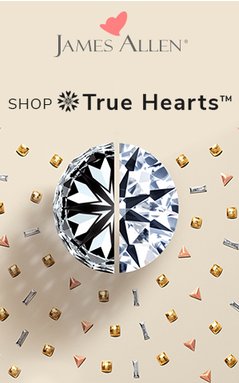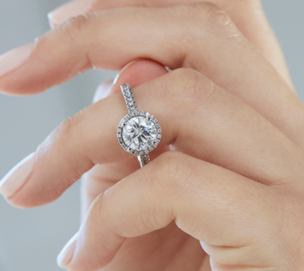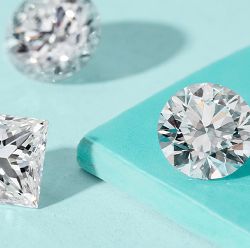
Moissanite or Lab Created Diamond?
Both moissanite and lab created diamonds are easier on the wallet than your traditional diamonds. Moissanite definitely wins the price war – but as I will show you in this article lab grown diamonds win --hands down-- on all other counts.
I've seen a few people posting pictures of their rings accompanied by a word that sounds like it's a member of a biblical a tribe of wet rags: Moissanite.
Yes, it sounds like "moisten".
Ok, I understand. In their search for that a shiny sparkly stone, ring shoppers want to get the most for their dollar. So it stands to reason they will check out the different available options. Moissanite has recently become more popular since the patent expired on it and it became commercially viable to manufacture them en masse. Moissanite however is not diamond.
Lab created diamonds and moissanite might seem superficially similar so you may wonder if there's any major difference worth bothering about. Well, they are actually quite different.
Here's the tl;dr summary:
LAB-CREATED DIAMONDS = REAL DIAMONDS
Clear enough?
MOISSANITE ≠ DIAMOND
“Wait, what?" you say.
Yup.
Lab-created diamonds are for all intents and purposes no different to real diamonds!
They’re chemically, structurally, and visually no different to diamonds that have existed for aeons. Those stones we all think of when we say the word "diamond" are identical to the ones made in a lab. The high-pressure, high-temperature, diamond-creating conditions that usually take place deep underground are replicated in a lab. Lab conditions are not nearly as difficult to create as the forming of a new planet which may or may not form diamonds. All kidding aside, it's even easier than the effort of mining diamonds underground. This is why lab-created diamonds are presently more affordable than earth-created diamonds.
Moissanite isn’t a diamond, it’s a silicon carbide!
Even the discovery of Moissanite is bizarrely back-to-front. It was synthesized in 1902 as silicon carbide. Then in 1904 Henri Moissan discovered some naturally occurring silicon carbide in a place sounding anything but heavenly: Canyon Diablo, AZ.
The moissanites you find being sold for engagement rings are synthesized in a lab under a thermal growing process. This silicon carbide crystal is a completely different material that looks very similar to diamond but is still an imitation of the real thing. Moissanite is often marketed as a cheaper alternative to diamond, but it’s an inferior option given the pricing and availability of ‘real’ lab-created diamonds. Moissanite is the lightest weighing material of all diamond simulants at about 10% lighter than diamond. Moissanite doesn’t have anywhere near the same brilliance or clarity as a real diamond, and it has none of the fire.
Moissanite exhibits something called thermoluminescence. This means it changes when heated. Thermoluminescence is a form of luminescence that is exhibited by certain crystalline materials, such as some minerals, when previously absorbed energy from electromagnetic radiation or other ionizing radiation is re-emitted as light upon heating of the material. So moissanite is better suited for scientific instruments than as a symbol of commitment and enduring love.
Let’s compare lab-created diamonds and moissanite point by point:
1. COLOR STEADFASTNESS
LAB DIAMONDS
A diamond’s color is stable. The lab-created diamond you buy today will look exactly the same when you eventually pass it down to your grandchildren.
MOISSANITE
Moissanite exhibits “thermochromism,” this means that it is sensitive to color change when the temperature is over 150° F (65 C). These are usually temporary, but these heat-sensitive color changes can sometimes be permanent.
2. COLOR
LAB DIAMONDS
Colorless to extremely colorful. Diamonds can exhibit a full range of colors. Diamonds form naturally in various conditions resulting occasionally in some striking and intense fancy colors. From canary yellow, purple, to the very rare and expensive vivid pink. Of course they also occur in completely colorless form.
MOISSANITE
Moissanites display a slight tint, usually a type of yellowish or greenish hue.
3. SPARKLE
LAB DIAMONDS
Lab-created diamonds have a refractive index of 2.42 and their faceting pattern returns light remarkably. The combination of their brilliance (reflected white light), fire (refracted color) and scintillation (surface sparkle) give diamonds their unparalleled true sparkle. Brilliant and sparkly!
MOISSANITE
Moissanite actually has a higher refractive index than diamonds, at 2.65, and their faceting pattern is different, leading their brilliance to display a “rainbow effect.” The rainbow effect tends to make moissanite look fake to the well-trained eye, and is especially noticeable under natural light and in larger stones.
4. IDEAL SIZE
LAB DIAMONDS
Lab-created diamonds sparkle the same at any carat weight. Go big, go small, go whatever you like.
MOISSANITE
Moissanite’s exhibits a “rainbow effect” which can look fake and is especially noticeable in larger moissanite stones. Stick with smaller sizes.
5. WEAR-AND-TEAR
LAB DIAMONDS
Diamond is the hardest stone (it has the highest rating of 10 on Moh’s hardness scale). It’s not susceptible to scratching.
MOISSANITE
Extremely hard (9.25 on Moh’s hardness scale), but is still more susceptible to scratching than diamonds.
6. COST
LAB DIAMONDS
Diamonds are usually the more expensive choice. However, lab-created diamonds are the affordable diamond option, allowing you to get a 30% larger stone for the same cost as earth-created diamonds.
MOISSANITE
Moissanites are a cheaper option, though buyers must take into account the lifetime costs of maintenance such as having it professionally cleaned. Moissanite’s value is mostly sentimental.
7. BRILLIANCE
LAB DIAMONDS
Diamonds have a different type of brilliance to moissanite. Reflected light (white light) is called brilliance. The colors refracted through the diamond are called dispersion or fire. The sparkle of a diamond is called scintillation. This means diamonds, including lab diamonds have three types of diamond light return. It's the combination of these three types of light return that form the attractiveness of diamonds.
MOISSANITE
Moissanites can easily be spotted as they do have a distinct sparkle. looking at a diamond next to a moissanite it's easy to spot the difference as moissanite sparkles differently to the way than diamonds sparkle. There are several reasons the sparkle is different. For one they aren't cut in the same way as diamonds are. Moissanites have a very flashy look, which makes some people feel they give the impression of somehow being artificial, enhanced or "fake". The colorful flashiness is more noticeable if the piece is larger.
8. FLUORESCENCE
MOISSANITE
Moissanite fluoresces orangish red.
LAB DIAMONDS
Lab diamonds do not fluoresce.
9. STATEMENT
MOISSANITE
A moissanite is definitely a cheaper option. It's a flashy looking artificial mineral. It says "I got you a flashy lab made silicon carbide gem like mineral compound. It's not a gem, it's not a diamond, but it looks like one, and it only cost me 10% what a diamond would have cost me".
LAB DIAMONDS
A lab diamond says: "I got you the symbol of durability, value, and commitment: diamond. Sure, it's made in a lab, but this way we can celebrate what a diamond signifies without digging a great big hole in the ground and mining for it to prove my love."
10. WHEN FOUND IN NATURE
MOISSANITE
Moissanite does exist in nature but it's extremely rare. Even when it does decide to make an appearance, moissanite is not welcome. It's usually found as an inclusion in diamonds. So in that case the moissanite is detracting from a diamond's beauty and making it less desirable. Apart from that it's found in meteorites, those big stones from outer space that kill and have been responsible for several extinction level events.
LAB DIAMONDS
Diamonds, when found in nature are one of the wonders of the universe.
11. GRADING REPORTS
MOISSANITE
Good luck trying to find a moissanite that has a grading report. The problem is that there is no consistent grading available for moissanite. A jeweler might tell you that a moissanite is comparable to an F color, but since the FTC allows for this kind of ad hoc appraisal to be one or two color grades off you can be certain that color descriptions made this way will rarely be accurate.
LAB DIAMONDS
Lab diamonds are sold with an accompanying grading report so you know exactly what you are getting. The study into the properties of diamonds can all be applied to lab diamonds. There are numerous scientific studies into how diamonds perform that makes it possible to understand a diamond's light play by simply constructing a computer model of the diamond. Pricing for lab diamonds can therefore be much fairer and it is much easier to compare prices between dealers as you can rest assured that you know what each diamond is purported to be based on the grading report. As the majority of lab diamonds are graded by IGI this makes the process of shopping for a lab diamond so much easier.


